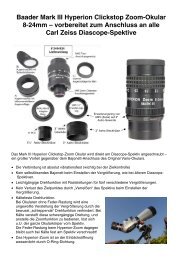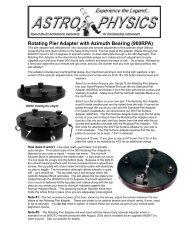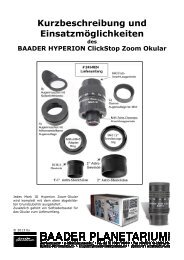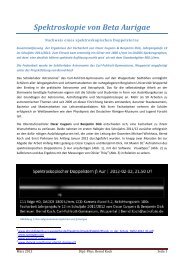G E N E R A L IN FO R M A TIO N - Baader Planetarium
G E N E R A L IN FO R M A TIO N - Baader Planetarium
G E N E R A L IN FO R M A TIO N - Baader Planetarium
You also want an ePaper? Increase the reach of your titles
YUMPU automatically turns print PDFs into web optimized ePapers that Google loves.
B A A D E R P LA N E TA R IU M N V 110/220<br />
G E N E R A L <strong>IN</strong> <strong>FO</strong> R M A <strong>TIO</strong> N<br />
In order to dem onstrate the m echanics of the heavens in a heliocentric m anner as w ell as for a<br />
geocentric negative projection of stars and constellations, m any thousands of this B A A D E R<br />
m odel have been proving their scientific capabilities during the past eighteen years to students<br />
and am ateur astronom ers all over the w orld. This planetarium presents an absolutely unique<br />
m ethod of dem onstrating celestial relationships; patens have been registered in all m ajor<br />
industrial countries.<br />
D escription<br />
Like all B A A D E R P LA N E TA R IU M S the N V 110/220 m odel consists of three units: the star globe<br />
being black and transparent sim ultaneously, the solar system including its electric drive system ,<br />
located inside the globe and – finally – the planetarium ’s base containing the control equipm ent<br />
and transform er.<br />
The celestial globe of the B A A D E R P LA N E TA R IU M N V 110/220 is m ade of plexiglass (R ) w hich<br />
has been subjected to a black color treatm ent to obtain approxim ately 5% transparency. This<br />
m aterial provides an am azing optical effect: U nder direct light the sphere w ill appear alm ost<br />
opaque due to the light absorbing and reflecting properties of the plexiglass (R ). H ow ever, w hen<br />
looking at the planetarium in a som ew hat darker room , the hum an eye w ill adapt itself to<br />
existing light conditions and the sphere w ill now appear transparent: The solar S ystem inside<br />
the globe can be clearly seen.<br />
U sing three colors, stars and constellations have been printed on the outside of the celestial<br />
globe: stars up to 5th m agnitude are show n and the constellations are indicated by connecting<br />
lines. E quatorial graduations perm it locating the position of fixed stars and enable the<br />
dem onstrator to explain the principles of astronom ical navigation.<br />
B y using w hite printing at the inside surface of the globe, the observer gets the im pression of<br />
view ing a real sky w ith w hite stars against a black background. The ecliptic path has been<br />
included also as a line, indicating the m onths in order to actually show the real position of the<br />
m odel earth at any tim e of the year. The w hole globe can be turned around all axes and aligned<br />
w ith the apparent position of the sky; clearly dem onstrating w hy at different tim es of the year<br />
only specific sections of the sky can be seen.<br />
The solar system of the B A A D E R P LA N E TA R IU M N V 110/220 uses a m icroscope light bulb at<br />
the center of the sphere constituting a point source of light. It can be covered w ith a rem ovable<br />
plastic globe providing a diffuse light body representing the sun.<br />
The planets M ercury, V enus and M ars are show n along w ith their orbit paths. They can be<br />
adjusted by hand to dem onstrate their positions during opposition and conjunction. The outer<br />
planets are show n by their orbits w hich are printed on the inside of the globe. This enables the<br />
observer to com pare the relative positions and inclinations of the various orbits against E arth's<br />
ecliptic plane.
The earth-m oon system is equipped w ith a m iniature drive m otor, having a variable speed. The<br />
follow ing m otions can be dem onstrated.<br />
1. The earth revolving around the sun (revolution)<br />
2. The earth rotating around its ow n axis (rotation)<br />
3. E arth's axis pointing tow ards the celestial poles.<br />
4. The m otion of the m oon around the earth<br />
5. The shifting of the lunar nodes!<br />
This m ode of representation and the precision achieved constitute an unique com bination. lt<br />
greatly facilitates apprehension of m any relationships of the m echanics of the heavens, for<br />
instance:<br />
The m echanics and causes of day and night, the m echanics of the seasons,<br />
com prehension of the m oon’s m otion, light phases and eclipses. W ith equal<br />
ease a num ber of phenom ena can be explained: The tides, the tim e zones of<br />
the earth, solar and sidereal tim e, the shift of the lunar nodes, the relation<br />
betw een the celestial equator and the ecliptic plane, the starry sky at various<br />
periods of the year, circum polar stars and their relation to geographical latitude,<br />
the position of the orbital plane of a sate lite, the m echanics of the light phases<br />
of V enus, the P latonic year, the changing of the equinoxes, the relativity of the<br />
observer’s position, synodic, sidereal and draconitic tim e of the m oon, a<br />
satellite’s position in space.<br />
The base of the planetarium contains the transform er as w ell as tw o knobs for control of the<br />
m odel earth’s m otion and the light intensity of the projection lam p. A flexible cable is used to<br />
connect the transform er to the gear unit of the m odel earth. Thus the globe including its internal<br />
gear system s can be turned around any axis at any instant.<br />
B y taking off the plastic cover producing the m odel sun’s diffuse light, the projection capabilities<br />
of the B A A D E R P LA N E TA R IU M N V 110/220 can be dem onstrated. The point source of light<br />
provides a negative projection of the starry sky – as seen at any tim e of the year onto the ceiling<br />
of a room or hall up to a height of 15 ft – or onto one of our projection dom es.<br />
S pecifications:<br />
D iam eter of the globe: 20 Inches (50 cm )<br />
Total height: 21 Inches (52 cm )<br />
W eight: 8 lbs (3,8 kg)<br />
Tim e of D elivery: please inquire<br />
D O K : G \P rosp\B aa\P lan\E ngl\G eneral-Inform ation-0213-w ord.doc<br />
E lectrical parts:<br />
P rojecting lam p: O sram 8017/6V /15W<br />
Transform er: 8 V /18V A w ith recifier for<br />
m otor supply. S tandard<br />
m odel suitable for<br />
100-125V or 210-240V<br />
voltage alternatively (m ust<br />
be specified !)<br />
M otor: M iniature D C m otor, ratio<br />
of speed control 1:8 fitted<br />
w ith fixed ratio gear<br />
system .

















